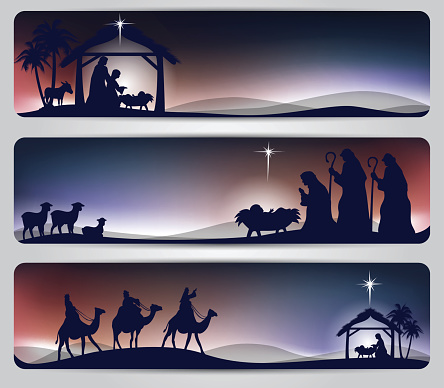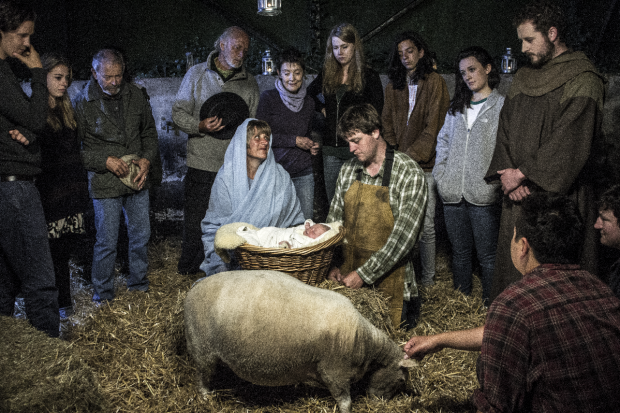St. Francis of Assisi staged the first nativity scene in a cave outside of the town of Greccio, Italy on Christmas Eve night 1223.

It is said that St. Francis was inspired to re-create the nativity scene because he was disgusted with the greed and materialism that was rampant in Italy at that time. He felt that people had forgotten that Jesus came to us not as a rich king but as a poor child. In planning the scene St. Francis wrote to his friend Giovanni, “I want to do something that will recall the memory of that child who was born in Bethlehem, to see with bodily eyes the inconveniences of his infancy, how he lay in the manger, and how the ox and ass stood by.”
The idea of a nativity scene was so radical that St. Francis first wrote to Pope Honorius III for permission before he moved forward with his plans.
He then invited the villagers to come gaze upon the scene while he preached about “the babe of Bethlehem” (Francis was supposedly so overcome by emotion that he couldn’t say “Jesus”).

Bonaventure also claims that the hay used by Francis miraculously acquired the power to cure local cattle diseases and pestilences.
But we’ll let St. Bonaventure tell this story:
“It happened in the third year before his death, that in order to excite the inhabitants of Grecio to commemorate the nativity of the Infant Jesus with great devotion, [St. Francis] determined to keep it with all possible solemnity; and lest he should be accused of lightness or novelty, he asked and obtained the permission of the sovereign Pontiff. Then he prepared a manger, and brought hay, and an ox and an ass to the place appointed. The brethren were summoned, the people ran together, the forest resounded with their voices, and that venerable night was made glorious by many and brilliant lights and sonorous psalms of praise. The man of God [St. Francis] stood before the manger, full of devotion and piety, bathed in tears and radiant with joy; the Holy Gospel was chanted by Francis, the Levite of Christ. Then he preached to the people around the nativity of the poor King; and being unable to utter His name for the tenderness of His love, He called Him the Babe of Bethlehem. A certain valiant and veracious soldier, Master John of Greccio, who, for the love of Christ, had left the warfare of this world, and become a dear friend of this holy man, affirmed that he beheld an Infant marvelously beautiful, sleeping in the manger,  Whom the blessed Father Francis embraced with both his arms, as if he would awake Him from sleep. This vision of the devout soldier is credible, not only by reason of the sanctity of him that saw it, but by reason of the miracles which afterwards confirmed its truth. For example of Francis, if it be considered by the world, is doubtless sufficient to excite all hearts which are negligent in the faith of Christ; and the hay of that manger, being preserved by the people, miraculously cured all diseases of cattle, and many other pestilences; God thus in all things glorifying his servant, and witnessing to the great efficacy of his holy prayers by manifest prodigies and miracles.”
Whom the blessed Father Francis embraced with both his arms, as if he would awake Him from sleep. This vision of the devout soldier is credible, not only by reason of the sanctity of him that saw it, but by reason of the miracles which afterwards confirmed its truth. For example of Francis, if it be considered by the world, is doubtless sufficient to excite all hearts which are negligent in the faith of Christ; and the hay of that manger, being preserved by the people, miraculously cured all diseases of cattle, and many other pestilences; God thus in all things glorifying his servant, and witnessing to the great efficacy of his holy prayers by manifest prodigies and miracles.”
Francis’ display came in the middle of a period when mystery or miracle plays were a popular form of entertainment and education for European laypeople. These plays, originally performed in churches and later performed in town squares, re-enacted Bible stories in vernacular languages. Since church services at the time were performed only in Latin, which virtually no one understood, miracle plays were the only way for laypeople to learn scripture. Francis’ nativity scene used the same method of visual display to help locals understand and emotionally engage with Christianity. His “living” nativity allowed the people present to truly participate in the human mystery of the incarnation, as well as the spiritual mystery. God become flesh was enacted out before their eyes, and “God with us” – Emmanuel – became an experience rather than simply a Scripture quote.
Within a couple of centuries of Francis’ inaugural display, nativity scenes had spread throughout Europe. It’s unclear from Bonaventure’s account whether Francis used people or figures to stand in for Jesus, Mary, and Joseph, or if the spectators just used their imagination, but later nativity scenes included both tableaux vivants and dioramas, and the cast of characters gradually expanded to include not only the happy couple and the infant, but sometimes entire villages.  The familiar cast of characters we see today—namely the three wise men and the shepherds—aren’t biblically accurate. Of the four gospels in the New Testament, only Matthew and Luke describe Jesus’ birth, the former focusing on the story of the wise men’s trek to see the infant king, the latter recounting the shepherds’ visit to the manger where Jesus was born. Nowhere in the Bible do the shepherds and wise men appear together, and nowhere in the Bible are donkeys, oxen, cattle, or other domesticated animals mentioned in conjunction with Jesus’ birth. But early nativity scenes took their cues more from religious art than from scripture.
The familiar cast of characters we see today—namely the three wise men and the shepherds—aren’t biblically accurate. Of the four gospels in the New Testament, only Matthew and Luke describe Jesus’ birth, the former focusing on the story of the wise men’s trek to see the infant king, the latter recounting the shepherds’ visit to the manger where Jesus was born. Nowhere in the Bible do the shepherds and wise men appear together, and nowhere in the Bible are donkeys, oxen, cattle, or other domesticated animals mentioned in conjunction with Jesus’ birth. But early nativity scenes took their cues more from religious art than from scripture.
After the reformation, crèches became more associated with southern Europe (where Catholicism was still prevalent), while Christmas trees were the northern European decoration of choice (since Protestantism—and evergreens—thrived there). As nativity scenes spread, different regions began to take on different artistic features and characters. For example, the santon figurines manufactured in Provence in France are made of terra cotta and include a wide range of villagers. In the Catalonia region of Spain, a figure known as the caganer—a young boy in the act of defecating—shows up in most nativity scenes.
And, of course, there is still a tradition in many churches to create their own “living nativity,” with schools hosting a Nativity Play and churches offering a “living manger” – continuing the tradition of Francis in bringing the mystery of the Christmas Babe to life anew each December.
Information for this page compiled from these sources:
http://archstl.org/stewardship/page/understanding-nativity-scene
http://www.slate.com/articles/life/holidays/2012/12/nativity_scene_history_why_people_put_up_cr_ches_for_christmas.html
http://www.catholiceducation.org/en/culture/catholic-contributions/st-francis-and-the-christmas-creche.html
